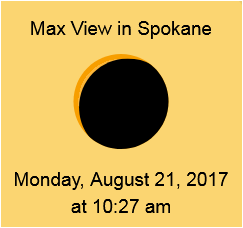
(Photo credit: stevespanglerscience.com)
A total solar eclipse is coming August 21, 2017. Here in Spokane, we will see a partial eclipse at 10:27am.
What’s the Difference
According to Space.com, “A total solar eclipse happens when the central disk of the sun is completely covered by the moon.”
For us here in Spokane, the moon will cover part of the sun, about 90%.

How to Watch the Solar Eclipse
Protect your eyes – you do not want to view the eclipse without protective eyewear. It can be bright enough to cause damage to your eyes. According to the Spokane Eye Clinic, “Regular sunglasses are not good enough. Neither are the temporary sunglasses you get at our office after having a dilated eye exam.” It is best to use solar viewing glasses. These glasses are made from special-purpose solar filters. NASA and AAS recommend using glasses that meet the standard of ISO 12312-2.
Tips While Viewing According to eclipse2017.nasa.gov/safety

- Always inspect your solar filter before use; if scratched or damaged, discard it. Read and follow any instructions printed on or packaged with the filter.
- Always supervise children using solar filters.
- Stand still and cover your eyes with your eclipse glasses or solar viewer before looking up at the bright sun. After looking at the sun, turn away and remove your filter — do not remove it while looking at the sun.
- Do not look at the uneclipsed or partially eclipsed sun through an unfiltered camera, telescope, binoculars, or other optical device.
- Similarly, do not look at the sun through a camera, a telescope, binoculars, or any other optical device while using your eclipse glasses or hand-held solar viewer — the concentrated solar rays will damage the filter and enter your eye(s), causing serious injury.
- Seek expert advice from an astronomer before using a solar filter with a camera, a telescope, binoculars, or any other optical device. Note that solar filters must be attached to the front of any telescope, binoculars, camera lens, or other optics.
- If you are within the path of totality (https://go.nasa.gov/2pC0lhe (link is external)), remove your solar filter only when the moon completely covers the sun’s bright face and it suddenly gets quite dark. Experience totality, then, as soon as the bright sun begins to reappear, replace your solar viewer to look at the remaining partial phases.
- Outside the path of totality, you must always use a safe solar filter to view the sun directly.
- If you normally wear eyeglasses, keep them on. Put your eclipse glasses on over them, or hold your handheld viewer in front of them.
Total Solar Eclipse Tidbits
The last total solar eclipse in the United States was February 26, 1979.
The next total solar eclipse is expected April 8, 2024, crossing from Texas to Maine.
The earliest known recorded total solar eclipse was May 3, 1375 in Babylon.
The upcoming eclipse is the first in 99 years to go from one U.S. coast to the other.
A total solar eclipse can cause a temperature decrease of up to 20 degrees.
After a total solar eclipse, it takes about an hour before day light is restored.
Total solar eclipses cannot be seen at the North and South Poles.





